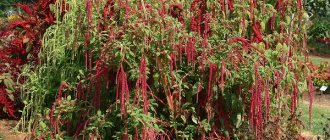Phlox awl-shaped planting and care photo
Carpet plantings are often found in garden plots. Ground cover plants can quickly disguise empty parts of a flower bed or rock garden, giving them a luxurious look. One of the popular representatives of perennial ground covers is phlox subulate; planting and care photo of the plant; you will find recommendations for caring for it in this article. If agricultural techniques are followed, fluffy bushes can delight you with bright blooms twice a season, and their unique aroma is hardly comparable to anything.
Care
Phlox subulate variety "Aurora"
Growing and caring for phlox subulate includes traditional procedures.
Watering
Moderation when watering is one of the conditions for the successful development of the plant. This beautiful subshrub is hardy and can tolerate short dry periods. Excess moisture becomes more problematic for the plant and can lead to root rot and plant diseases. Therefore, water the flowers sparingly after the top layer of soil dries out. In dry summers, watering is done once every 2-3 days; the rest of the time, it is enough to water phlox subulate once a week.
Weeding
Growing and caring for decorative shrubs is not complete without systematic weeding. The soil is cleared of weeds before planting, trying to remove the roots present in the soil mixture. In the future, the plant is weeded regularly.
Top dressing
During the season you need to fertilize the phlox several times. This will prolong flowering and make the plant strong and hardy. Most often, gardeners feed the plant with liquid manure; a small amount (25 g) is diluted in 10 liters of water. You can also use mineral fertilizers.
| FEEDING | TERM | WHAT TO FEED |
| First feeding | before flowering (end of April) | diluted manure or fertilizers based on nitrogen and potassium. |
| Second feeding | June | manure solution with added superphosphate |
| Third feeding | end of July | ash solution (ash (300 g), hot water (2 l) is boiled for 7-10 minutes. After the solution has completely cooled, water the plants with it). Instead of an ash solution, you can use phosphorus-potassium fertilizer. |
Trimming
In spring, you can prune the plant. This will allow you to form a beautiful bush. When pruning at other times (summer, autumn), the buds present on the shoots are removed, which leads to problems next year. Timely removal of corollas that have bloomed and dried out ensures a second flowering (August - September).
Video “Phlox awl-shaped - planting, care and reproduction”
Phlox awl-shaped description, photo
Phlox subulata belongs to the cyanaceae family. The genus got its name thanks to the botanist Carl Linnaeus. He compared wild shrubs to a bright flame, because this is how the name of the genus is translated from Greek. They began to call it awl-shaped because of the shape of the leaf blades, similar to a stationery tool.
Wild relatives are common in North America. These perennials grow in dry areas on talus and sandy hills, sometimes found among sparse thickets of shrubs.
Know! Exotic garden cultivars have good frost resistance. Even if damaged from too cold a winter, they are able to recover quickly.
Exotic bushes are evergreen mats; the color of the foliage does not change even under a layer of snow cover. The height of this low-growing subshrub is only 15-17 cm. The plant has creeping, densely leafy shoots. The stems are highly branched and consist of many short internodes. When they come into contact with the ground, they send out roots and grow quite quickly. The foliage cover is very dense and tough. The length of the plate is 2-2.5 cm. The leaves are narrow, lanceolate, without a petiole, arranged in opposite order.
The root system of the perennial is fibrous and lies superficially. It penetrates into the soil no more than 15 cm. Reproduction is both seed and vegetative.
Funnel-shaped flowers are located at the end of the stems, 5-7 pieces in an inflorescence. The corolla consists of five divided petals with a small notch along the edge. The diameter of the bud does not exceed 2-2.5 cm. The color of the petals can be snow-white, cream, pink, lilac and transitional shades. Often there are cultivars with a contrasting eye, the shape of which can vary. It differs from other cultivated representatives of its genus in its early flowering. The first wave is abundant, occurs in May and lasts 1-1.5 months. Secondary flowering is less abundant and occurs in August and September.
This is interesting! Due to the similarity of phlox subulata buds to carnation flowers, North Americans nicknamed it moss carnation.
Despite the small size of the buds, the bush is highly decorative. There are so many tiny fragrant inflorescences that during the flowering period the stems and foliage are practically invisible. After wilting, an oval box is formed, inside which are brown seeds.
Botanical description of the plant
Awl-shaped phlox is a spring-blooming perennial ground cover crop. The miniature variety does not exceed 10-15 cm in height. The stems are densely covered with bright green needle-like foliage, which is how the species got its name. The root system is located near the soil surface.
The perennial is good because from early spring until frost its turf remains emerald green, even under snow it retains its greenery. Lush flowering pleases 2 times per season (from the end of May to the last days of June and from the beginning of August to mid-September). At the tops of the stems, star-shaped flowers open in various shades of white, pink, blue, red or purple.
Types and varieties
The first specimens of phlox subulata reached Europe in 1746. Breeders considered this event very successful for their work. The first attempts at hybridization helped to develop garden forms of the plant that differed in bush height and flower color. Even the most noble gardens in England could only boast of the presence of wild specimens that had undergone a process of natural mutation.
The painstaking work of flower growers has made it possible to create a mass of garden hybrids over two centuries. Unfortunately, it was not possible to preserve the genetic ancestors - the natural mutation of the perennial played a role. Garden cultivars bred by breeders have acquired a compact shape, rapid growth, resistance to the vagaries of weather and diseases, and their decorative properties have increased. Domestic breeders cannot boast of success - due to harsh climatic conditions, heat-loving exotics do not form seeds. All commercially available seed material is made abroad. The main producers of phlox subulata seeds are Holland, Germany, England, Japan, USA and France.
Know! You will not be able to get seeds from your moss carnation plantation.
For their combination of beautiful appearance, unique aroma and unpretentiousness, gardeners are very fond of the following varieties of the American guest:
- Aurora. The variety is of great value to gardeners. Lovers of abundant flowering will definitely be pleased with this cultivar. It forms lush “drifts” of a pale pink hue, which from a distance looks like white. The star-shaped buds reach a diameter of 2.5 cm. The total height of the bush is 10-12 cm. The variety is ideal for carpet planting and beautifying empty areas of the garden.
- Amazing Grace. It has white buds 1.5-1.8 cm in diameter. In the central part of the corolla there is a purple eye. The height of the cultivar is 12 cm.
- Coral eye. Has stars of a light pink hue. Near the tube there is a scarlet star-shaped eye. The variety is characterized by fast growth and good survival rate. Forms cushions 12 cm high.
- Thumbelina. A variety with cool pink petals framing a dark red eye. Rugs grow very quickly and have a height of 10-15 cm.
- More perfect. The owner of small, dazzling white, wheel-shaped flowers. Their diameter does not exceed 1.5 cm. The bushes themselves are also short, 8-10 cm in height. The hybrid is most common among white varieties.
- Tellaria. It has lilac buds with a scarlet star-shaped eye. The diameter of the bud is 2-2.3 cm. It stands out among its relatives for its long flowering period. Plant height 12 cm.
- G. F. Wilson. The petals are painted in a delicate bluish-lavender hue. They have the shape of a star with a diameter of 1.5-1.8 cm. Landscape designers prefer this strong, hardy and tall (among other varieties) hybrid. It forms thick cushions up to 20 cm high.
- Temiskaming. One of the most popular varieties. It differs from its garden counterparts in the density of the bush and dark leaves with a burgundy tint. The flowers are dark crimson with a diameter of 2 cm. The mat reaches a height of 15 cm. It takes root well during vegetative propagation.
- Vivid. Dense low pillows have rich pink round buds.
- Candy Stripes. The owner of white petals with a pink stripe in the center. The diameter of the buds is 1.7-2.0 cm. Low mats (10 cm) have gained the love of gardeners for their unusual coloring and abundant and long-lasting flowering.
Know! The cultivar “Netteleto Variegata” compares favorably with its counterparts with its beautiful foliage. The plates are painted in a dark green shade and have a pink border along the edges, due to which the hybrid is used in landscaping as an ornamental foliage plant.
Interesting varieties
The phlox genus includes about 80 species of colorful summer flowers and hundreds of varieties. In gardens, paniculata phlox (flox paniculata) is usually grown, characterized by a vertical structure and a height of up to 100 cm. However, the ground cover phlox subulata (Phlox subulata), which is the subject of this article, is gaining increasing popularity. A very similar ground cover species is also Phlox stolonifera - both species bloom in late May - early June.
Inspired by the grace of perennials, botanists in the 19th century crossed wild and domesticated species, achieving new aesthetic effects. Today, advanced cultivation and crossing of phlox is carried out by the Americans and the Dutch.
Of the latest creations, the early flowering varieties of the Fabulous group with very interestingly colored flowers (Blue Dark Center, Blue Violet, Rose, White) are interesting. They bloom very early - in March. These plants bush well, maintain a compact shape, and cover the surface well.
An interesting new product is the GoldiPhlox group, which includes 5 varieties with large flowers in color: white, white-blue, red-pink and two shades of pink. These varieties bloom early and are characterized by the same height within the group.
Photo. Variety "Goldiflox pink" GoldiPhlox Pink
Varieties from the “Spring” group are characterized by large flowers of bright colors:
- “Blue” Blue – with light blue flowers;
- “Duck Pink” Dark Pink – with pink flowers;
- “Hot Pink” Hot Pink – dark pink variety;
- “Lilas” Lilac – dark pink;
- “Ash” Purple – purple;
- "White" White - white.
Photo. "Spring Hot Pink" Spring'Hot Pink
New varieties are also excellent for planting in balcony and terrace containers - single or multi-species compositions.
White, beige
White varieties are often used; they combine well with other types and are excellent for gardens and rock gardens:
- “Mashsne” Maischnee – dense bush, profusely flowering;
- "Morgenstern" Morgenstern - flesh-colored flowers with a dark eye;
- "Calvides White" Calvides White;
- “White Delight” White Delight – large flowers;
- “Amazing Grace” Amazing Grace;
- "Bavaria" Bavaria - beautiful white flowers with a blue eye.
Pink
Pink varieties are very popular. They have warm, delicate colors and look great on the edges of flower beds. Examples:
- "Camlensis" Camlaensis - large dark pink flowers;
- "Moerheimi" Moerheimi - intense pink flowers;
- "Ronsdorfer Schone" Ronsdorfer Schone - salmon-pink flowers;
- “Scarlet Flame” Scarlet Flame – hot pink;
- "Phlox trot pink" Phlox trot Pink is a new variety with very large bright pink flowers.
Purple
These varieties look very bright in the flowerbed and amaze with the intensity of the color of the flowers. Example:
- "Ash Beauty" Purple Beauty;
- "Alice Wilson" Alice Wilson.
Reds
Red cushions of ground cover phlox will look bright spots on a ridge or in a rock garden. They usually play first fiddle in flower beds.
Examples of varieties:
- "Atropurpurea" Atropurpurea - flowers are intensely dark red;
- "Temiskaming" Temiskaming - dark leaves, red-carmine flowers;
- "Red Wings" Red Wings.
Blue
Blue phlox seeds have recently appeared on the market. The most beautifully presented are 3 blue varieties:
- Emerald Cushion Blue;
- F. Wilson - a vigorous variety, sensitive to frost - requires winter shelter;
- “Blue Dac Sente” Blue Dark Center – blue-white with a dark eye.
Two-color
Two-color flowers look very interesting, with a red or coral stripe through the center of the petals:
- "Amazing Grace" Amazing Grace - white flowers with a pink-purple eye;
- "Coral eye" Coral Eye - light pink flowers with a red-coral eye;
- "Candy Stripes" Candy Stripes - two-color, white and pink flowers;
- "Nelsonium" Nelsonii - white flowers with a red eye;
- “Marjorie” Marjorie – pink with a dark pink eye.
Planting phlox subulate in the garden
Each garden crop requires a specific approach to planting. The success of cultivation and obtaining abundant flowering depends on the chosen location.
Choosing a landing site
Despite the unpretentiousness of the moss carnation, it will need to create conditions that best match its natural habitat. At home, the perennial prefers to bask in the rays of sunlight, so choose an area of the garden with maximum illumination.
The awl-shaped phlox will easily tolerate a slight drought, but excess moisture in the soil will destroy it. In addition to susceptibility to various fungal diseases, waterlogging threatens loss of decorativeness and gradual decline in growth. A bush planted in an area with nearby groundwater will certainly die. You should worry about creating a good drainage system in advance. In addition, the area should be well ventilated.
Important! Avoid planting flowers in lowlands. Choose a place where there is sufficient snowfall in winter.
Soil preparation
The North American visitor is accustomed to growing in poor soil. It will happily settle on fertilized soil, but it will not bloom. The plant will use all the nutrients absorbed by the root system to form green mass.
The soil for planting should be loose and not absorb too much moisture. To give it such properties, add sand to the prepared area. The heavier the soil, the more it will be needed. There is no need to specially enrich the substrate with humus, but you will have to adjust the pH value.
The soils of Central Russia are characterized by high acidity. From acidic soils, exotic plants will not be able to fully absorb the microelements necessary for the successful development of flower stalks. Before planting, the area should be limed with dolomite flour. The application rate will directly depend on the acidity of the soil. As a rule, 200-400 grams per square meter of planting will be sufficient.
Remember! The liming process will be successful only when dolomite flour is mixed with earth. Carefully dig up the area and level it with a rake.
Technology of planting awl-shaped phlox
Before planting, the prepared area should be carefully examined for the presence of weed roots. Field bindweed is especially dangerous. This stubborn weed will certainly grow through the turf of the bush and ruin its appearance. Other weeds are no less dangerous - in addition to fighting for nutrients, if you try to pull them out of the flowerbed, you can easily damage the root system of the moss carnation. Like other ground covers, its roots lie very close to the surface of the earth.
Planting is done in small holes. Their width depends on the degree of development of the root system. Keep in mind that the roots in the hole will need to be carefully straightened. The planting step is at least 40-50 cm, because the perennial will grow in one place for about 5-6 years and during this period the bushes will expand greatly in width. Planted specimens are watered and the top layer of soil is mulched with peat.
The planting time will directly depend on the type of planting material. So, seedlings are planted after the frosts have subsided, cuttings with heels in early spring, and cuttings in late August or early September.
Choosing a place and soil for planting
Phlox loves sunny places. But it will also feel fine in the shade. The main condition is less moisture. In wetlands the plant dies.
If possible, it is better to dilute the soil with sand. A drainage type of soil is welcome, however, this item is not necessary due to the unpretentiousness of the plant. The only thing worth considering is that if you plan to plant in black soil, which will often be moistened, you can’t really count on flowering.
It is also worth noting the plant’s love for the wind. Phlox should not be planted between tall plants or walls, because of which air masses will not pass through it.
Caring for a plant in the garden
Caring for our tropical guest is not particularly difficult. The exotic is so unpretentious that even a novice gardener can cope with its cultivation. In addition to standard weed removal, flower growers should take care of the correct watering schedule and timely fertilizing.
Watering
The North American does not tolerate excess moisture, so the watering regime should be as moderate as possible. The procedure is carried out in the absence of sun - early in the morning or after sunset. Watering should be done strictly at the root, because water that gets on the buds and leaves can cause burns and spoil the fragrant flowers. In hot weather, maintain a moderate watering regime, but make it abundant. For 1 meter of planting you will need about 15-20 liters of water.
Important! You can water awl-shaped phloxes only with warm water. Cold liquid, especially on hot days, will cause the stems to crack.
Top dressing
In order for the bushes to please with the splendor and abundance of flowers, it is worth taking care of feeding. Follow the following fertilization schedule:
- Beginning of the growing season. After hibernation, fertilizing with humates is carried out. They stimulate growth and will help phlox recover faster.
- During the budding period, a potassium-phosphorus complex is introduced. These microelements will have a beneficial effect on the formation of flower stalks.
- After flowering ends, you can fertilize with a full complex.
- During the entire growth period, root and surface fertilizing with an ash solution can be carried out. It contains no nitrogen, which promotes abundant foliage growth but has a detrimental effect on flowering.
To prepare an ash solution, boil 300 grams of ash in two liters of water. Boiling time 10 minutes. The prepared extract must be cooled, filtered and the volume brought to 10 liters.
On a note! An ash solution can prevent pest attacks. Feel free to use it as a foliar feeding.
Planting in open ground
The root system of the plant is superficial, so when planting, phloxes are not deeply buried. When digging the soil, weed rhizomes are carefully removed so that they do not interfere with the growth of turf. Until the phlox plantings turn into a continuous carpet, regular weeding is a mandatory maintenance procedure in the first 1–2 years.
Phlox seedlings are planted in prepared holes or holes to a depth of 10–15 cm at a distance of 25–30 cm from each other. After planting, they are watered abundantly.
The article “Perennial Phlox - Types and Popular Varieties,” which describes the varieties of all known perennial phlox, will help you choose subulate phlox seeds.
Bush formation
Another important measure for caring for ground cover is the formation of a bush. Be sure to remove damaged branches and wilted inflorescences. This will promote rapid growth and help avoid diseases. To stimulate the formation of next year's flower buds, completely remove the shoots after flowering ends (in July). In autumn, pruning cannot be carried out; awl-shaped phloxes overwinter green.
Bonita
Bushes of the Bonita variety cover the flowerbed with such a lush carpet of flowers that in a few years they can turn your front garden into a real sea of lavender. The flowers of this phlox have a pleasant pink tint; the plant has excellent winter hardiness and is easy to grow.
| Petal color | Bush height (cm) | Bush diameter (cm) | Flowering time |
| Hot pink with a dark pink spot at the base | 5-15 | 30-50 | May June |
Features of cultivation, flowering of awl-shaped phlox
There are several important nuances in the process of cultivating an American guest, which will be discussed in this section of the article.
How long does the plant bloom?
Moss carnation is extremely decorative. Its emerald greenery pleases the eye throughout the entire growth period. Even the awl-shaped phlox leaves for the winter in a green outfit.
During the flowering period, lush mats are completely covered with delicate fragrant buds. Even their small sizes do not affect their high decorative value. At the end of May or the first ten days of June, your garden will begin to smell fragrant and be covered with bright pillows. The formation of new buds lasts for 4-6 weeks, after which the above-ground part withers and requires radical pruning.
Know! With proper care and a long, warm, dry autumn, colorful buds will again appear on the fluffy rug in early September.
Bavaria
Bavaria is a variety of phlox with unusual elegant colors. The flowers of this plant are two-colored: the white petals at the base are colored with purple “rays.”
These phlox bloom twice - in late spring - early summer and in late summer - early autumn. True, the second flowering is more sparse.
| Petal color | Bush height (cm) | Bush diameter (cm) | Flowering time |
| White, purple at base | 15 | 50 | May-June, August-September |
Crop rotation
For our exotics, an important factor in proper growth is compliance with crop rotation. This is due to the increased risk of nematode infection. A microscopic worm that infects strawberries will easily move to the tender shoots of moss cloves. To avoid infection with nematodes, use for cultivation those areas where garden berries have not grown over the past 2-3 years.
Marigolds and calendula will help protect the American guest. Nematodes cannot stand the aroma of these garden inhabitants, so these plants are the best predecessors on the site.
Atropurpurea
An unpretentious ground cover plant that forms a dense carpet of dark green, needle-like leaves. It grows well. Prefers light, loose soil, preferably loam. Drought-resistant, does not tolerate excess moisture. A creeping bush, strewn with carmine-pink flowers with a purple eye, looks very impressive in mixborders, in crevices between stones in rockeries, and decorates retaining structures.
| Petal color | Bush height (cm) | Bush diameter (cm) | Flowering time |
| Purple pink | 15-17 | 50-60 | Mid-May – mid-June |
Shelter of awl-shaped phlox for the winter
The American guest is quite winter-hardy. In the southern regions, it will calmly overwinter without shelter. Colder climates will require careful management of the dormant period.
With the onset of frost, the root collar of the perennial should be mulched with peat. In addition to serving as a warm blanket, it will be an excellent top dressing next spring. To protect the rhizome as much as possible from the cold, cover it with spruce branches.
Take it into service! If the winter has little snow, you should try to add snow to the flowerbed. Provided there is a snow cover more than half a meter high, the exotic will survive even the harshest winter.
Damping off with the onset of an early thaw is much worse for shoots. Even if the shoots are severely damaged, the perennial will recover fairly quickly. Fertilizing with potassium humate stimulates growth.
Scarlet Flame
During flowering, the bushes of this awl-shaped phlox are covered with fairly large flowers with a diameter of about 2 cm. The name of the variety translates as “scarlet radiance,” but the flowers of Scarlet Flame are more of a dark pink hue.
Among the special care requirements of these phloxes, one can highlight only sufficient lighting (sun or partial shade) and high water permeability of the soil - subulate phloxes react poorly to waterlogging.
| Petal color | Bush height (cm) | Bush diameter (cm) | Flowering time |
| Dark pink | 10-15 | 40-60 | May-June, August-September |
Methods for propagating awl-shaped phlox
The heat-loving perennial reproduces well vegetatively. For these purposes the following can be used:
- green cuttings;
- cuttings from the rhizome;
- cuttings with a heel (layering).
In addition, some gardeners grow phlox from seeds. It is unlikely that you will be able to get them from your own plot, but buying them at a garden center is not difficult.
Propagation by cuttings
Your green pet reproduces well from cuttings. They take root quite quickly without any treatment. It is enough to cut off the top of the shoot 8-10 cm long, remove the lower leaves from it and plant it in a pot. Use a mixture of peat and sand as a substrate. Cuttings can be done before budding or after the appearance of new foliage in August.
It is very easy to get layering. To do this, creeping shoots should be pinned and covered with earth. They will quickly take root, and after a while it will be possible to separate them from the mother plant and plant the cuttings in a permanent place.
This is interesting! Experienced gardeners recommend breaking off branches for cuttings rather than cutting them. So, they take root faster.
Violet Pinwheels
The jagged and inverted petals of this phlox resemble the blades of a pinwheel - this shape gives the variety its name. The flowers are a soft lilac color with thin petals. Forms clumps that are soft to the touch and resemble a pillow. Like all awl-shaped phloxes, it does not tolerate excessive watering, so the soil should be loose and well-drained. In deep shade it withers and stops blooming. Perfect for a well-lit rock garden, rocky hill, mixborder. Growing on a slope, it will be free from the problem of stagnant water.
| Petal color | Bush height (cm) | Bush diameter (cm) | Flowering time |
| Purple violet | 10-15 | 45-60 | Second half of May - early June |
When to sow awl-shaped phlox seeds for seedlings
Those wishing to grow seedlings are advised to sow them in March, but sowing can be done before winter. The seeds are placed on the bed in increments of 3-4 cm and sprinkled with a little soil. Seedlings will appear in the spring. After throwing out 3-4 leaves, they can be planted into holes in increments of 15-20 cm. In the second year, the seedlings will bloom.
On a note! Experienced gardeners consider growing moss carnation by seed a waste of time. This method is used in practice only by breeders.
Purple Beauty
Forms turf in the form of a lush cushion. It blooms from mid-May to mid-June; in August-September a second wave of flowering is often observed, but it is more sparse. The flowers are lilac in color with dark purple “strokes” at the core of the corolla. Prefers stony and rocky slopes, hilly places, well lit by the sun. Flowers need soil that is not too fertile, but loose and without excessive moisture. In a mixborder, rock garden, or just on the lawn, these phloxes will become a bright color accent.
| Petal color | Bush height (cm) | Bush diameter (cm) | Flowering time |
| Magenta (purple-lilac) | 15-20 | 30-45 | May-June, August-September |
How to properly divide a five-year-old phlox bush
To obtain cuttings, five-year-old bushes are used. As they grow, the stems become lignified in the middle part, forming a bare area. Dividing the bush promotes its rejuvenation.
This operation is carried out in mid-August. Carefully remove the rhizome from the ground and divide it into several parts so that each has a sufficient number of stems and a developed root system. Use the same planting algorithm as described above, only add a little humus or rotted compost to the hole. It will help better rooting.
Candy Stripes
Phlox flowers Candy stripes resemble beautiful candies: the petals are painted with white and pink stripes and fuchsia spots. This beauty does not require special care; it can withstand even the most severe frosts. It is enough to plant it on the southwestern side of the site, water it moderately and feed it periodically.
| Petal color | Bush height (cm) | Bush diameter (cm) | Flowering time |
| White with pink stripes and a purple spot at the base | 10-15 | 60 | May June |
Pests and diseases
With proper agricultural technology, an unpretentious exotic plant is unlikely to be susceptible to the fungal diseases listed below:
- If, when examining the leaves, you find a whitish coating of powdery mildew, treat with copper sulfate or Bordeaux mixture.
- Rust is also caused by a pathogenic fungus. The disease manifests itself by the appearance of reddish-brown spots on the leaves, which blur over time and lead to the death of the plate. The affected parts should be removed and treated with Topaz.
- Phoma causes fragility of shoots and drying out of leaves. This is the work of a microscopic fungus, which a colloidal sulfur solution will help destroy.
- Septoria is another fungal disease that can be identified by the appearance of brown spots on the leaf blades. If the disease is not stopped, the spots will begin to grow and interfere with photosynthesis, causing the perennial to die. Preventive treatments with copper-containing preparations will help in the fight against fungus.
Remember! Compliance with the rules of agricultural technology, preventive examinations and spring treatment with Bordeaux mixture are the main measures for the prevention of fungal diseases.
Variegation is a plant virus. It manifests itself as a change in the color of the corolla, which becomes covered with stripes. At the first symptoms of the disease, remove infected specimens and burn them.
Among the pests, nematodes and caterpillars are dangerous. When attacked by stem nematodes, the color and shape of the leaves change and growth slows down. It is better to take preventative measures in the form of crop rotation than to try to fight the parasite. Caterpillars can be collected by hand and destroyed, or infected specimens can be treated with any insecticide against leaf-eating insects.
How to plan a flower bed
A naturally beautiful plot or flowerbed will not work if you don’t plan everything in advance.
Considering that phlox is a creeping shrub, it needs to be given an appropriate role. If you are planning a flowerbed in which there will be nothing except phlox, then there is nothing special to plan, you just need to plant it in accordance with the recommendations.
But if the flowerbed is located on an artificial hill, next to a fountain and other elements, it is important to give the phlox its due place. For example, a popular solution is when the subulate frames the perimeter of the flowerbed. If the flowerbed is elevated, it beautifully plays with the shape and continues to spread downwards.
Important! Phlox should be planted away from water - excess can adversely affect development.
Phlox flower bed
Phlox awl-shaped in landscape design, combination with other plants
Thanks to their incredible endurance, winter hardiness and unique appearance, fragrant bushes have earned the love of landscape designers. Low-growing annuals are used to decorate rockeries, create bright cushions on the lawn, and fill empty spaces in a mixborder or on an alpine slide. The moss carnation looks great along paths, buildings, and borders. It will become a beautiful filling for the discount.
Other ground covers will be good neighbors in the flowerbed - alyssum, young, sedum. In the background you can plant ornamental grasses or low-growing coniferous, decorative and deciduous shrubs. The combination of awl-shaped phloxes with primroses, irises, asters, and snapdragons looks very harmonious.
Application in landscape design
Due to the variety of shades of flowers, compactness of the bush and undemanding nature, awl-shaped phlox is actively used in landscape design. This flower in the garden can be not only a background, but also an accent in the center of any flower bed.
The plant is suitable for creating low borders along paths in the garden.
It is used in rock gardens, rockeries and mixborders.
The culture is in perfect harmony with the stones.
Phloxes look quite colorful next to carnations, periwinkles, and sedums.
Knowing how to grow phlox subulate, you can get a beautiful plant that can decorate your garden plot, forming a continuous carpet on the lawn. A bright and bewitching flower will cause a lot of admiring glances and pleasant compliments.
Forum: reviews, growing tips
Experienced gardeners highly appreciate the unpretentiousness and winter hardiness of moss carnation. They note the luxurious appearance of the flowering mat and recommend it for growing even on depleted soils.
Natalya admires the ease of caring for such a beautiful and fragrant representative of garden flora. While dividing the bush, she accidentally damaged several branches. The gardener decided to dig them in and received new planting material, which bloomed the very next year.
Victoria raises Native American in balcony boxes. The gardener claims that you can get a luxurious flowering pillow on a sunny balcony, the main thing is to monitor the condition of the soil and apply fertilizing.
Valeria decided to grow phlox through seedlings. She noted the capriciousness of the seedlings and their susceptibility to various diseases. But the nurtured bushes made excellent queen cells, which made it possible to quickly fill the garden with bright spots.
Nikolay works as a landscape designer. He recommends planting each variety at some distance from its neighbor. The moss carnation grows quickly and its shoots intertwine, forming a not very aesthetic multi-colored spot. Free-standing pillows look much more impressive.
Conclusion
After reading this article with bright photos, you will probably want to add awl-shaped phlox to your garden, especially since planting and caring for it is unlikely to cause any difficulties.
Growing conditions
Subulate varieties of phlox do not have any special requirements other than lighting. The most important factor is to provide them with a highly sunny position. In partial shade they bloom poorly or not at all, become very thin, lose their good shape, and may begin to hurt.
The perennial has no special soil requirements. The natural habitat of the plant is sandy soils. In the garden, ordinary garden soil is sufficient for it, if it is permeable.
Phlox grows better on soils:
- water-permeable;
- sandy;
- fertile;
- moderately humid.
Phloxes do not like soil:
- very wet;
- cold;
- heavy;
- clayey.
Plants do not have exorbitant needs for water and tolerate temporary drought well, although they look more beautiful and grow better if they are watered regularly.
Although awl-shaped varieties of phlox are considered resistant to diseases and pests, in unfavorable conditions they can get sick, become weak, and vulnerable. A shaded area often leads to the development of fungal pathogens.
Popular varieties
star Rain
Star Rain is a popular Drummonda variety, its distinctive feature is the unusual shape of its petals, usually they have a sharp or slightly pointed shape. Thanks to this handicap, the flowers resemble stars; with the help of this variety you can create a real starry sky in a flowerbed.
Phlox drummond starry
Tetra Riesen
This group of varieties belongs to fairly tall plants; they have fairly large flowers; they can reach 6 cm in diameter.
The variety of colors allows you to choose a plant that will exactly suit your landscape design.
Phlox Tetra Riesen
Feuerbahl
If you are a lover of red shades, then this variety is for you. Phlox of this variety is a plant up to 30 cm in length, which has large flowers of only a red-pink hue. Shades may vary in color intensity.
Phlox paniculata Feuerbahl
Twinkling star
It is not for nothing that this variety was given such a name; its flowers resemble twinkling stars due to the pointed shape of the petals and unusual coloring. Often their color is a gradient, from bright colors to soft pink or white.
Phlox drumonda twinkling star
Growing perennial phlox from seeds. Growing perennial phlox from seeds
Perennial phloxes are planted by seeds, as a rule, in order to obtain a large number of plants, for example, to create borders or dividing strips in the garden.
You can purchase seeds in the store or collect seed pods in the garden yourself in the fall.
Note! Phlox from seeds, with proper care, bloom in the second year. Just be sure to cover them for the winter!
Phlox seeds can be sown before winter in open ground or at the end of winter and beginning of spring for seedlings.
Sowing in autumn in open ground
If you are going to sow phlox seeds directly into the beds at the end of autumn (October-November), then it is very convenient to do this in plastic rings that can be cut from 5 liter plastic bottles. According to the rules for sowing before winter, you need to sow only on frozen soil and cover it with dry soil without watering.
Advice! It is advisable to increase the sowing rate in winter compared to sowing seeds in containers.
Sowing seedlings in spring
It is convenient to sow phlox at home in disposable containers with a lid, in which drainage holes must be made.
You can take the most common universal soil for growing seedlings, preferably with vermicompost. The soil should be fertile and loose.
Step-by-step instructions for sowing perennial phlox seeds:
- Fill the containers with a little more than half of the soil. Level it out well.
- Spray the soil with a solution before planting to disinfect it.
- Gently and evenly spread the seeds over the surface. The seedlings of perennial phlox are not small and are convenient to sow.
- Sprinkle soil on top.
- Cover the container with a lid or spunbond.
- Now you will need to place the container with the crops in the fresh air under the snow, as close to the ground as possible (it is best to place it on a board or plywood so that there is a flat surface). Under such conditions, the most acceptable temperature is maintained for the germination of phlox seeds. Thus, they will undergo natural stratification.
If you don’t have the opportunity to bring containers with crops to the garden (let’s say you live in an apartment and you can’t get to your dacha in winter), then you can use another method of growing phlox from seeds.
Pre-soaked seeds are kept for 2 weeks at a temperature of +18-22 C degrees. Then mixed with sand and placed in the refrigerator for stratification for 6 or more weeks until the seeds hatch. After this, they are planted in containers to a depth of 1 cm and grown at home at a temperature of +17-25 C degrees.
Planting in open ground and further care of perennial phlox
When phlox seedlings have 5-6 true leaves, they should be planted in open ground. Usually this time is around May, when the frosts will have passed and the seedlings will no longer be in danger.
It is advisable to choose a place that is sunny or with light partial shade.
For the normal development of a flower, soil is required to be loose and fertile, rich in organic matter. If your soil is too heavy, then add sand, peat or any other soil loosening agent.
Further care for phlox consists of regular watering as the soil dries, loosening and weeding, as well as timely fertilizing.
Advice! If you want to achieve better tillering (branching), then pinch 4-5 pairs of leaves.
It is especially important to water frequently on hot and dry summer days, otherwise flowering will not be as abundant and rich.
It is important not to overwater the flower, as the plant does not tolerate stagnation of water and may simply rot.
Worth knowing! It is advisable to replant phloxes every 4-6 years to a new location.
White Delight
White Delight is a snow-white awl-shaped phlox that will decorate borders, rockeries and alpine slides in your garden with its blooms for 3-4 weeks in late spring - early summer. Like other phloxes of this species, it is not picky about soil acidity and care, but prefers sunny areas.
| Petal color | Bush height (cm) | Bush diameter (cm) | Flowering time |
| Snow-white | 10-15 | 30-50 | May-June, August-September |
Reproduction
Plants are usually propagated by dividing the bush. It is better to carry it out in autumn and or spring. It is necessary to dig up the bushes and carefully divide them into parts. Plant the bushes in prepared, moist soil. The shoots need to be cut off from the tops, then the plant will not give them extra strength and will quickly take root in a new place.
Over time, phloxes become not as beautiful as before, the number and size of flowers will decrease.
You can propagate phlox using cuttings. When the plant fades, you need to cut the shoots. The leaves from below are removed. Cuttings can be planted either in wet sand or in soil. Rooting will occur in about three weeks.
The seed method is rarely used. If the plant is a hybrid, it is difficult to propagate in this way. In general, phloxes often reproduce themselves by seeds. It's surprising that the new plants don't look like their parents. They may have a completely different color and shape. You can also propagate the flower by layering from the stems. This method of propagation is similar to cuttings. It is best to plant new flowers every 5 years.
Caring for phlox seedlings after germination
- The first thing you need to do is place the container in a bright and warm place, this was discussed earlier. You also need to turn the container in different directions towards the light during the day and ventilate the greenhouse once a day;
- You will be able to see the shoots in a week; after they appear, you need to remove the cover and lower the temperature by a couple of degrees;
- At each stage of plant growth, the soil should be kept sufficiently moist and watered with a sprayer before germination. When the seedlings appear, you need to water them using tweezers and try not to get water on the plants themselves.
It is also recommended to highlight the plants, since the normal daylight hours are 12-14 hours
How to properly pluck phlox seedlings
Phloxes tolerate diving very well, so feel free to take on this task. From the general container you need to move them into single cups, which should be quite large.
The same soil can be used, but it must be sprayed with Fitosporin-M solution.
The time of replanting can be determined by the appearance of the plant; it can be replanted when two or three leaves appear on it
Step-by-step instructions for picking seedlings:
- During transplantation, you can damage the roots; to avoid this, you should water the plants several hours before the procedure;
- Drainage material must be placed at the bottom again;
- Next, add the prepared soil, but do not fill the container to the very brim;
- Make a hole in the center of the cup;
- Then pick up the plant along with the root and a piece of soil; this can be done with a fork or some kind of stick;
- Place the plant in the hole, cover with soil and compact;
- At the end of the picking, water the roots, but try not to get it on the plants themselves.
When picking, weak and rotten shoots should be discarded.











